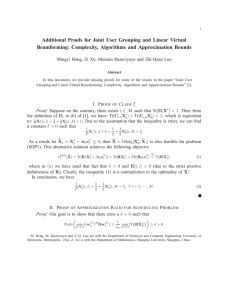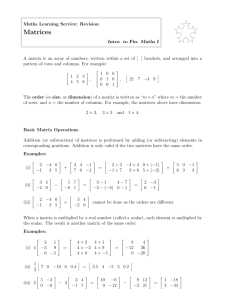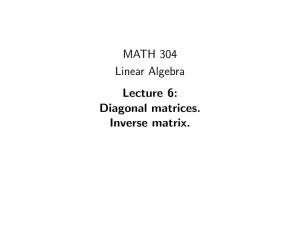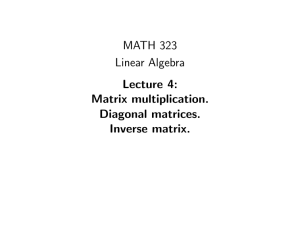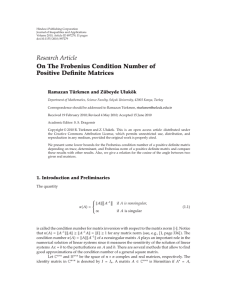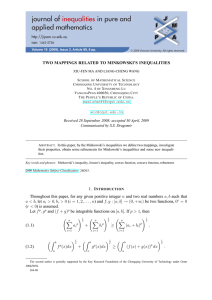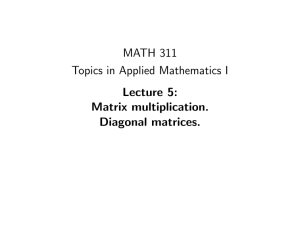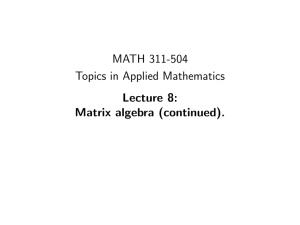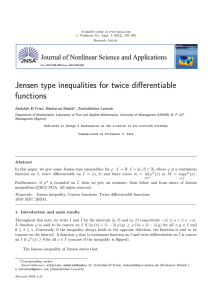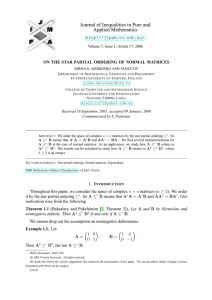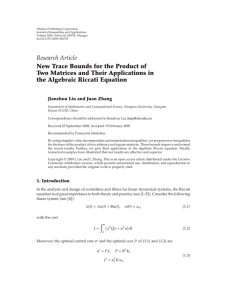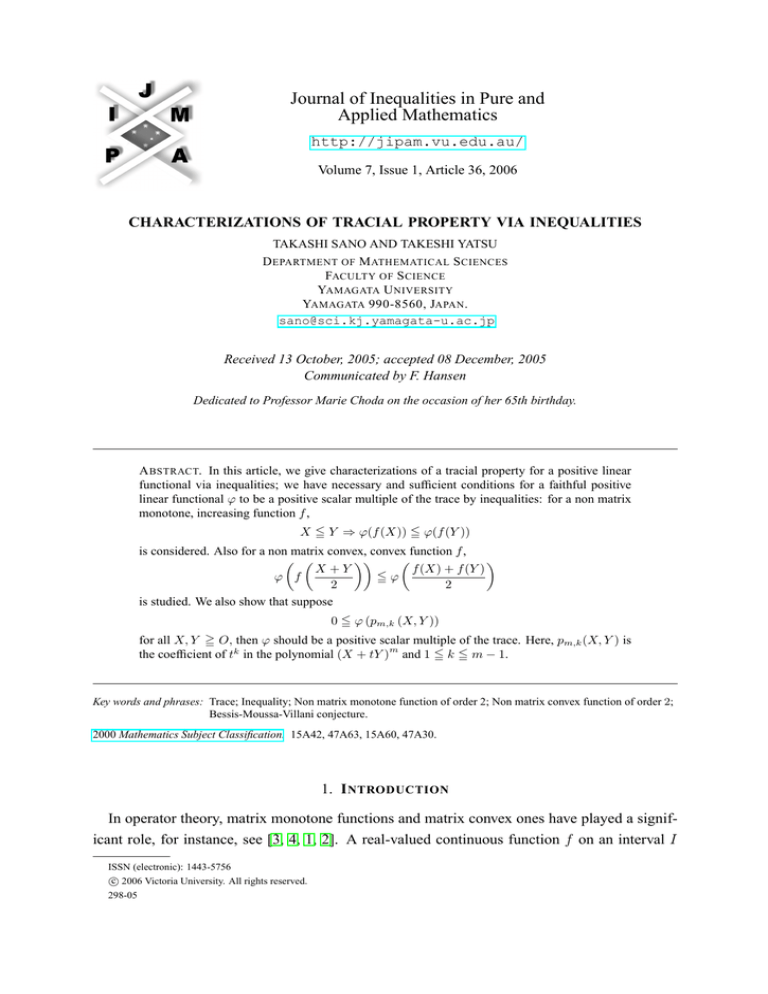
Journal of Inequalities in Pure and
Applied Mathematics
http://jipam.vu.edu.au/
Volume 7, Issue 1, Article 36, 2006
CHARACTERIZATIONS OF TRACIAL PROPERTY VIA INEQUALITIES
TAKASHI SANO AND TAKESHI YATSU
D EPARTMENT OF M ATHEMATICAL S CIENCES
FACULTY OF S CIENCE
YAMAGATA U NIVERSITY
YAMAGATA 990-8560, JAPAN .
sano@sci.kj.yamagata-u.ac.jp
Received 13 October, 2005; accepted 08 December, 2005
Communicated by F. Hansen
Dedicated to Professor Marie Choda on the occasion of her 65th birthday.
A BSTRACT. In this article, we give characterizations of a tracial property for a positive linear
functional via inequalities; we have necessary and sufficient conditions for a faithful positive
linear functional ϕ to be a positive scalar multiple of the trace by inequalities: for a non matrix
monotone, increasing function f ,
X 5 Y ⇒ ϕ(f (X)) 5 ϕ(f (Y ))
is considered. Also for a non matrix convex, convex function f ,
X +Y
f (X) + f (Y )
ϕ f
5ϕ
2
2
is studied. We also show that suppose
0 5 ϕ (pm,k (X, Y ))
for all X, Y = O, then ϕ should be a positive scalar multiple of the trace. Here, pm,k (X, Y ) is
m
the coefficient of tk in the polynomial (X + tY ) and 1 5 k 5 m − 1.
Key words and phrases: Trace; Inequality; Non matrix monotone function of order 2; Non matrix convex function of order 2;
Bessis-Moussa-Villani conjecture.
2000 Mathematics Subject Classification. 15A42, 47A63, 15A60, 47A30.
1. I NTRODUCTION
In operator theory, matrix monotone functions and matrix convex ones have played a significant role, for instance, see [3, 4, 1, 2]. A real-valued continuous function f on an interval I
ISSN (electronic): 1443-5756
c 2006 Victoria University. All rights reserved.
298-05
2
T. S ANO
AND
T. YATSU
(j R) is called matrix monotone of order n if X 5 Y implies f (X) 5 f (Y ) for all n × n
Hermitian matrices X and Y with eigenvalues in I. If f is matrix monotone of all orders, f is
said to be matrix monotone or operator monotone. When f is matrix monotone of order n, for
a positive linear functional ϕ on n × n matrices, we have
X 5 Y ⇒ ϕ(f (X)) 5 ϕ(f (Y ))
for n×n Hermitian matrices X and Y. Also, for an increasing function f and Hermitian matrices
X and Y with X 5 Y ,
Tr(f (X)) 5 Tr(f (Y ))
holds in which Tr is the standard trace on matrices (for more details, see the argument at the
beginning of Section 2).
A real-valued continuous function f on an interval I (j R) is called matrix convex of order
n if the inequality
X +Y
f (X) + f (Y )
f
5
2
2
is satisfied for all n × n Hermitian matrices X and Y with eigenvalues in I. If f is matrix
convex of all orders, f is said to be matrix convex or operator convex. When f is matrix convex
of order n, for a positive linear functional ϕ on n × n matrices,
X +Y
f (X) + f (Y )
ϕ f
5ϕ
2
2
holds for n × n Hermitian matrices X and Y with eigenvalues in I. And for a convex function
f and Hermitian matrices X and Y, we have
X +Y
f (X) + f (Y )
Tr f
5 Tr
2
2
(see basic facts on Jensen’s inequalities explained before the proof of Theorem 3.3).
In this article, we give characterizations of tracial properties for positive linear functionals via
inequalities; we have necessary and sufficient conditions for a faithful positive linear functional
ϕ to be tracial by inequalities: for a non matrix monotone, increasing function f ,
X 5 Y ⇒ ϕ(f (X)) 5 ϕ(f (Y ))
is considered. Also for a non matrix convex, convex function f ,
X +Y
f (X) + f (Y )
ϕ f
5ϕ
2
2
is studied. We have a criterion of non matrix monotonicity of order 2 or non matrix convexity
of order 2. We show a necessary and sufficient condition for the function
1
X 7→ {Tr(|X|p C)} p
(p > 2) to be a norm; the function is essentially the Schatten p-norm.
J. Inequal. Pure and Appl. Math., 7(1) Art. 36, 2006
http://jipam.vu.edu.au/
T RACIAL P ROPERTY VIA I NEQUALITIES
3
We also observe an inequality given by a coefficient of a certain polynomial: let pm,k (X, Y )
be the coefficient of tk in the polynomial (X + tY )m for X, Y ∈ Mn (C), m ∈ N, and t ∈ C
and 1 5 k 5 m − 1. Suppose that
0 5 ϕ (pm,k (X, Y ))
for all X, Y = O. Then ϕ should be a positive scalar multiple of the trace (see the remark of
Proposition 3.1 about the BMV conjecture).
We remark that divided differences are useful in this article: we refer the reader to [4, 2, 6].
We would like to express our sincere gratitude to Professor Tsuyoshi Ando for reading the
previous manuscripts and for fruitful comments. We would like to thank the members of
Tohoku-Seminar for valuable advice, especially Professor Sin-ei Takahashi for useful comments on Proposition 2.1 and Professor Fumio Hiai for pointing out the BMV conjecture to us.
We are also grateful to the editor and the referee for careful reading of the manuscripts and for
helpful comments.
2. I NEQUALITIES OF N ON M ATRIX M ONOTONE F UNCTIONS
Let Mn (C) be the set of all complex n-square matrices and let ϕ be a faithful positive linear
functional on Mn (C). Let f be an increasing function on I = (a, b). For Hermitian matrices
X, Y ∈ Mn (C) with a1 < X 5 Y < b1,
λi (X) 5 λi (Y )
for i = 1, 2, . . . , n in which λi is the i-th eigenvalue with λ1 = λ2 = · · · = λn . Since f is
increasing,
λi (f (X)) = f (λi (X)) 5 f (λi (Y )) = λi (f (Y )).
Hence, it follows that
Tr(f (X)) =
n
X
λi (f (X)) 5
i=1
n
X
λi (f (Y )) = Tr(f (Y )).
i=1
Let us study the following inequality for a strictly increasing, differentiable function f on
I = (a, b) and ε ∈ [0, 1] :
√
f (λ) − f (µ)
f 0 (λ)α2 (1 + ε) − 2α 1 − α2
(1 − ε) + f 0 (µ) 1 − α2 (1 + ε) = 0
λ−µ
for all µ, λ ∈ I (µ < λ) and all α ∈ [0, 1]. By considering 0 < α < 1, we have the equivalent
inequality
√
α
1 − α2 0
1 − ε f (λ) − f (µ)
√
f (µ) = 2
·
f 0 (λ) +
2
α
1+ε
λ−µ
1−α
for all µ, λ ∈ I (µ < λ) and all α ∈ (0, 1). Let
t := √
J. Inequal. Pure and Appl. Math., 7(1) Art. 36, 2006
α
,
1 − α2
δ :=
1−ε
.
1+ε
http://jipam.vu.edu.au/
4
T. S ANO
AND
T. YATSU
Then notice that
0 < α < 1 ⇔ 0 < t < ∞,
0 5 ε 5 1 ⇔ 0 5 δ 5 1,
and ε = 1 if and only if δ = 0. The corresponding inequality is described as
1 0
f (λ) − f (µ)
1
0
tf (λ) + f (µ) = δ
2
t
λ−µ
for all 0 < t < ∞ and all µ, λ ∈ I (µ < λ). Hence, by considering arithmetic-geometric mean
inequality in the left-hand side, we have
p
f (λ) − f (µ)
f 0 (λ)f 0 (µ) = δ
.
λ−µ
In this case, the condition ε = 1 or δ = 0 is given by
p
f 0 (λ)f 0 (µ)
inf f (λ)−f (µ) = 0.
λ>µ
λ−µ
We summarize our observation as follows:
Proposition 2.1. Let f be a strictly increasing, continuously differentiable function on I =
(a, b) and ε ∈ [0, 1]. Suppose that
p
inf
λ>µ
f 0 (λ)f 0 (µ)
f (λ)−f (µ)
λ−µ
= 0.
Then the inequality
√
f (λ) − f (µ)
f 0 (λ)α2 (1 + ε) − 2α 1 − α2
(1 − ε) + f 0 (µ)(1 − α2 )(1 + ε) = 0
λ−µ
holds for all µ, λ ∈ I (µ < λ) and all α ∈ [0, 1] if and only if ε = 1.
The following are examples:
xp (p > 1) on (0, a),
xp (p > 1) on (a, ∞),
ex on (a, ∞),
ex on (−∞, a)
for a constant a.
By direct computations, it is easy to see that each example satisfies the condition so details
are left to the reader.
Theorem 2.2. Let ϕ be a faithful positive linear functional on Mn (C) and let f be a function
as in Proposition 2.1. Then
(2.1)
ϕ(f (X)) 5 ϕ(f (Y )) whenever aI < X 5 Y < bI
if and only if ϕ is a positive scalar multiple of the trace.
J. Inequal. Pure and Appl. Math., 7(1) Art. 36, 2006
http://jipam.vu.edu.au/
T RACIAL P ROPERTY VIA I NEQUALITIES
5
Proof. At the beginning of this section it was explained that if ϕ is a positive scalar multiple
of the trace then the inequality (2.1) holds. We show the converse: since there is uniquely a
positive definite matrix D such that ϕ(X) = Tr(XD) for X ∈ Mn (C), we have to prove that
D is a positive scalar multiple of the identity matrix. Taking into consideration
ϕ (V ∗ · V ) = Tr (· V DV ∗ )
for all unitary V and that V DV ∗ is diagonal for a unitary V , we assume that D is a diagonal
matrix diag(d1 , . . . , dn ). To show that di = dj for any pair of di , dj (i 6= j), we consider
matrices X = (xkl ) with xkl zero except for (k, l) = (i, i), (i, j), (j, i), (j, j). Hence, it suffices
to consider the case n = 2 so that we suppose
D = diag(ε, 1)
for a number ε (0 < ε 5 1). We show that ε = 1.
Let
1
U=√
2
1 1
,
1 −1
Aλ,µ =
λ 0
,
0 µ
Pα =
!
√
α 1 − α2
α2
√
α 1 − α2
1 − α2
for λ, µ(λ 6= µ, a < λ, µ < b), α (0 5 α 5 1). For all t > 0,
U Aλ,µ U ∗ 5 U (Aλ,µ + tPα )U ∗ ,
and a1 < Aλ,µ + tPα < b1 for small t > 0. Then, by assumption
Tr(U f (Aλ,µ )U ∗ D) 5 Tr(U f (Aλ,µ + tPα )U ∗ D).
This implies that
d
∗
Tr(U f (Aλ,µ + tPα )U D) = 0.
dt
t=0
Also, the standard fact, see [2, page 124] for instance, yields
!
f (λ)−f (µ)
f 0 (λ)
d λ−µ
f (Aλ,µ + tPα ) = f (λ)−f (µ)
◦ Pα
0
dt t=0
f
(µ)
λ−µ
=
f 0 (λ)α2
√
f (λ)−f (µ)
α
1 − α2
λ−µ
f (λ)−f (µ)
α
λ−µ
√
1 − α2
f 0 (µ)(1 − α2 )
!
,
where ◦ stands for the Hadamard (i.e., entry-wise) product. Hence, it follows that
d
∗
0 5 Tr(f (Aλ,µ + tPα )U DU )
dt
t=0
d
= Tr
f (Aλ,µ + tPα · U ∗ DU )
dt t=0
!
√
!
f (λ)−f (µ)
2
f 0 (λ)α2
α
1
−
α
1
1+ε
−(1 − ε)
λ−µ
·
= Tr
√
f (λ)−f (µ)
0
2
−(1
−
ε)
1+ε
2
2
f (µ)(1 − α )
α 1−α
λ−µ
√
1
f (λ) − f (µ)
0
2
0
2
2
=
f (λ)α (1 + ε) − 2α 1 − α
(1 − ε) + f (µ)(1 − α )(1 + ε)
2
λ−µ
J. Inequal. Pure and Appl. Math., 7(1) Art. 36, 2006
http://jipam.vu.edu.au/
6
T. S ANO
AND
T. YATSU
for all α, λ, µ. Therefore, thanks to Proposition 2.1, the proof is completed.
In the proof of Theorem 2.2, a criterion of non matrix monotonicity of order 2 is obtained:
Corollary 2.3. Let f be a function as in Proposition 2.1. Then f is not matrix monotone of
order 2.
As a corollary of Theorem 2.2, we have
Theorem 2.4. Let C ∈ Mn (C) be a positive definite matrix and let p > 2 be given. Then the
function
1
µ(X) := Tr(|X|p C) p
(X ∈ Mn (C))
is a norm if and only if C is a positive scalar multiple of the identity matrix.
Proof. Suppose that µ is a norm. Then, by definition
µ(U X) = µ(X)
for all unitary U . For positive semidefinite matrices X, Y with X 5 Y , there is a contraction
P
1
1
V such that X 2 = V Y 2 and V is a convex combination of unitary matrices: V = N
i=1 λi Ui ,
PN
where λi = 0, Uj is unitary (j = 1, 2, . . . , N ) and i=1 λi = 1. Hence, we have
! !
N
N
1
1
X
X
1
1
µ X2 = µ
λi Ui Y 2 5
λ i µ Ui Y 2 = µ Y 2
i=1
i=1
since µ is a norm. Therefore, the faithful positive linear functional on Mn (C) defined by
ϕ(·) := Tr(· C)
satisfies
O 5 X 5 Y =⇒ ϕ X
p
2
5ϕ Y
p
2
.
p
2
Since > 1, it follows from Theorem 2.2 that C is a scalar multiple of the identity matrix; the
proof is completed.
3. I NEQUALITIES OF N ON M ATRIX C ONVEX F UNCTIONS
Let us start this section with the following observation of tracial properties:
Proposition 3.1. Let ϕ be a faithful positive linear functional on Mn (C). Let pm,k (X, Y ) be
the coefficient of tk in the polynomial (X + tY )m for X, Y ∈ Mn (C), m ∈ N, and t ∈ C and
1 5 k 5 m − 1. Suppose that
ϕ (pm,k (X, Y )) = 0
for all X, Y = O. Then ϕ should be a positive scalar multiple of the trace.
Remark that the non-negativity of Tr (pm,k (X, Y )) for all positive matrices X, Y is (equivalent to) the Bessis-Moussa-Villani conjecture (see [9, 7] and also [6]); it is known that it is the
case if one of the following is satisfied:
J. Inequal. Pure and Appl. Math., 7(1) Art. 36, 2006
http://jipam.vu.edu.au/
T RACIAL P ROPERTY VIA I NEQUALITIES
7
(1) k 5 2 (or m 5 5),
(2) n = 2 (see Fact 5 in [8]),
(3) n = 3, k = 6 (see [7]).
Proof. Due to the same argument for ϕ = Tr(·D) as in the proof of Theorem 2.2, it suffices to
consider the case n = 2 so that we suppose
D = diag(ε, 1)
for a number ε (0 < ε 5 1). We show that ε = 1.
At first consider the case k = 2; let
1 1 1
U=√
,
2 1 −1
1 0
B=
0 α
A=
√
2
α 1 − α2
√α
,
α 1 − α2
1 − α2
for a number α (0 < α < 1). Since A2 = A, pm,k (A, B) is described as
AB k + B k A + the terms including BAB + the terms AB k A.
1 0
Notice that for a number λ, A
A is
0 λ
!
√
√
α4 + α2 (1 − α2 )λ
α3 1 − α2 + α(1 − α2 ) 1 − α2 λ
,
√
√
α3 1 − α2 + α(1 − α2 ) 1 − α2 λ
α2 (1 − α2 ) + (1 − α2 )2 λ
1 0
1 0
A
=
0 λ
0 λ
!
√
α2
αλ 1 − α2
,
√
αλ 1 − α2 λ2 (1 − α2 )
and
AB k =
α2
√
α 1 − α2
!
√
αk+1 1 − α2
αk (1 − α2 )
.
Thus, we have for l = 2
AB l A = o(α) (α → 0),
BAB = o(α) (α → 0),
where o is Landau’s small o, and
0 5 ϕ(pm,k (U AU ∗ , U BU ∗ ))
= ϕ(U pm,k (A, B)U ∗ )
= ϕ U {AB k + B k A + o(α)}U ∗
1
k
k
= αϕ U
(AB + B A) + o(1) U ∗
α
J. Inequal. Pure and Appl. Math., 7(1) Art. 36, 2006
(α → 0).
http://jipam.vu.edu.au/
8
T. S ANO
AND
T. YATSU
Dividing this inequality by α > 0 and taking α as α → 0, we have
0 1
U∗
05ϕ U
1 0
1 0
=ϕ
0 −1
1 0
ε 0
= Tr
= ε − 1,
0 −1
0 1
since
1
AB k →
α
0 0
(α → 0).
1 0
Hence, ε = 1 or ε = 1.
For the case k = 1, let
1 0
C=
(= B 2 ).
0 α2
Then pm,1 (A, C) is AC + CA + the terms ACA. Notice that ACA = AB 2 A = o(α) (α → 0)
and the preceding argument for k = 2 works similarly. Therefore, the proof is completed.
Remark 3.2. It follows from the proof that the inequality assumption for 0 5 X, Y 5 1 is
sufficient for the assertion.
Theorem 3.3. Let ϕ be a faithful positive linear functional on Mn (C) and let f be a twice
continuously differentiable convex function on [0, ∞) with
f [2] (0, 0, 0) = 0,
f [2] (1, 0, 0) > 0,
where f [2] is the second divided difference of f . Then
f (X) + f (Y )
X +Y
(3.1)
ϕ
=ϕ f
2
2
holds for all X, Y = 0 if and only if ϕ is a positive scalar multiple of the trace.
Also, f (t) = tp (p > 2) on [0, ∞) is such an example.
Before giving a proof, let us recall basic facts on matrix convex continuous functions: let f
be a matrix convex continuous function of order n on an interval I. Then by definition,
f (X) + f (Y )
X +Y
=f
2
2
holds for Hermitian matrices X, Y ∈ Mn (C) with eigenvalues in I. This yields
f (X) + f (Y )
X +Y
ϕ
=ϕ f
2
2
for a positive linear functional ϕ on Mn (C).
We also recall basic facts on Jensen’s inequalities: for a convex continuous function f on I
and Hermitian matrices X, Y ∈ Mn (C) with eigenvalues in I,
f (X) + f (Y )
X +Y
(3.2)
Tr
= Tr f
2
2
J. Inequal. Pure and Appl. Math., 7(1) Art. 36, 2006
http://jipam.vu.edu.au/
T RACIAL P ROPERTY VIA I NEQUALITIES
9
is satisfied; this inequality is well-known, for instance, see [10, Proposition 3.1]: von Neumann observes the convexity x 7→ Tr(f (x)). E. H. Lieb gives a description of Tr(f (x)) and
B. Simon has further arguments. F. Hansen and G.K. Pedersen study generalizations; Jensen’s
operator inequality and Jensen’s trace inequality. There are also many articles on these kinds of
inequalities. See the introduction and references in [5] about Jensen’s inequalities.
Proof. We have a proof of Jensen’s inequality (3.2) for the reader’s convenience: Ky Fan’s
maximum principle (for instance, see [2, page 35]) means that
k
X
λi (X) +
k
X
λi (Y ) =
k
X
i=1
i=1
i=1
for k = 1, 2, . . . , n − 1, and
n
X
n
X
n
X
λi (X) +
i=1
λi (Y ) =
i=1
λi (X + Y )
λi (X + Y ),
i=1
where λi is then i-th eigenvalue
o with λ1 = λ2 = · · · = λn . In other words, λi
i (Y )
majorized by λi (X)+λ
. Then the majorization theory ([2, page 40]) says that
2
X
n
n
X
λi (X) + λi (Y )
X +Y
f
=
f λi
.
2
2
i=1
i=1
X+Y
2
is
Hence, from the convexity of f in the left-hand side, the above inequality (3.2) for Tr and f
follows. Therefore, if ϕ is a positive scalar multiple of the trace, we have the inequality (3.1).
We show the converse: at first we have explicit calculations for the case f (t) = tm (m ∈
N, m = 3) although we have a general treatment below: by assumption,
m
m X + (X + tY )m
X + (X + tY )
ϕ
−
=0
2
2
for t > 0 and X, Y = 0. Since
m
X m + (X + tY )m
1
1
− X + tY
= pm,2 (X, Y )t2 + o(t2 ) (t → 0),
2
2
4
0 5 t2 {ϕ(pm,2 (X, Y )) + o(1)}
(t → 0).
Thus, dividing this inequality by t2 > 0 and taking t as t → 0, we have
ϕ(pm,2 (X, Y )) = 0.
Hence, in this case the assertion follows from Proposition 3.1.
Let us consider the general case: since
f (X) + f (X + tY )
X + (X + tY )
ϕ
−f
=0
2
2
for t > 0 and X, Y = 0, the preceding argument yields similarly
2
d f (X + tY ) = 0.
ϕ
dt2 t=0
J. Inequal. Pure and Appl. Math., 7(1) Art. 36, 2006
http://jipam.vu.edu.au/
10
T. S ANO AND T. YATSU
For the same matrices A, B, U as in the proof of Proposition 3.1,
1 d2 f (A + tB)
2 dt2 t=0
is of the form
f [2] (1, 1, 1)ABABA + f [2] (1, 1, 0)ABAB(1 − A)
+ f [2] (1, 0, 1)AB(1 − A)BA + f [2] (0, 1, 1)(1 − A)BABA
+ f [2] (1, 0, 0)AB(1 − A)B(1 − A) + f [2] (0, 0, 1)(1 − A)B(1 − A)BA
+ f [2] (0, 1, 0)(1 − A)BAB(1 − A) + f [2] (0, 0, 0)(1 − A)B(1 − A)B(1 − A)
(see the formula of the second divided difference in [2, page 129] and remark that f [2] is symmetric and A is an orthogonal projection: A = 1 · A + 0 · (1 − A)). The order estimation for
BAB, AB 2 A and the assumption f [2] (0, 0, 0) = 0 mean
ϕ(f [2] (1, 0, 0)(AB 2 + B 2 A) + o(α)) = 0
(α → 0).
Hence, replacing A, B with U AU ∗ , U BU ∗ , we get
ϕ(U {f [2] (1, 0, 0)(AB 2 + B 2 A) + o(α)}U ∗ ) = 0
(α → 0).
Therefore, as in the proof of Proposition 3.1, the proof is completed.
In the proof of Theorem 3.3, a criterion of non matrix convexity of order 2 is obtained:
Corollary 3.4. Let f be a function as in Theorem 3.3. Then f is not matrix convex of order 2.
The same argument works for the following theorem whose proof is left to the reader:
Theorem 3.5. Let ϕ be a faithful positive linear functional on Mn (C) and let f be a continuously differentiable increasing function on [0, ∞) with
f [1] (0, 0) = 0, f [1] (1, 0) > 0,
where f [1] is the first divided difference of f . Then
ϕ(f (X)) 5 ϕ(f (Y )) whenever O 5 X 5 Y
if and only if ϕ is a positive scalar multiple of the trace.
f (t) = tp (p > 1) on [0, ∞) is such an example.
We remark that a proof can be obtained by the formula of the first divided difference in [1, p.
12] for
d f (A + tB)
dt t=0
as in the proof of Theorem 3.3.
J. Inequal. Pure and Appl. Math., 7(1) Art. 36, 2006
http://jipam.vu.edu.au/
T RACIAL P ROPERTY VIA I NEQUALITIES
11
R EFERENCES
[1] T. ANDO, Topics on Operator Inequalities, Hokkaido University, Sapporo (1978).
[2] R. BHATIA, Matrix Analysis, Springer-Verlag (1996).
[3] C. DAVIS, Notions generalizing convexity for functions defined on spaces of matrices, in Convexity: Proceedings of Symposia in Pure Mathematics, American Mathematical Society: 187–201
(1963).
[4] W.F. DONOGHUE, Jr., Monotone Matrix Functions and Analytic Continuation, Springer-Verlag,
(1974).
[5] F. HANSEN AND G.K. PEDERSEN, Jensen’s trace inequality in several variables, Int. J. Math., 14
(2003), 667–681.
[6] F. HANSEN, Trace functions as Laplace transforms, preprint (2005).
[7] C. HILLAR AND C.R. JOHNSON, On the positivity of the coefficients of a certain polynomial
defined by two positive definite matrices, J. Stat. Phys., 118 (2005), 781–789.
[8] C.R. JOHNSON AND C. HILLAR, Eigenvalues of words in two positive definite letters, SIAM J.
Matrix Anal. Appl., 23 (2002), 916–928.
[9] E.H. LIEB AND R. SEIRINGER, Equivalent forms of the Bessis-Moussa-Villani conjecture, J. Stat.
Phys., 115 (2004), 185–190.
[10] M. OHYA AND D. PETZ, Quantum Entropy and Its Use, Texts and Monographs in Physics,
Springer-Verlag (1993).
J. Inequal. Pure and Appl. Math., 7(1) Art. 36, 2006
http://jipam.vu.edu.au/

